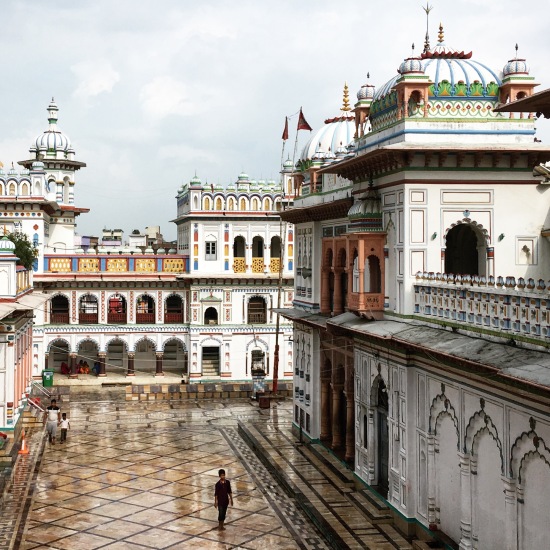The terrai is a part of Nepal quite different from Kathmandu Valley or the mountain regions. It is flat and green and very humid even in late September – and it is home of a Women’s Development Center set to preserve the ancient artform of Mithila, colourful, vibrant paintings quite unlike anything else on the Indian subcontinent.Janakpur, a small city in the south-east of Nepal, doesn’t boast many sights. According to a Lonely Planet entry is a “cesspool”, and a visit there proves the travel guide right. Yet still the city is popular with pilgrimage tourists especially from India. The reason is the stunning temple Janaki Mandir, a testament to the legend of Hindu gods Rama and Sita and as legend has it, built on the site where Sita was born. The temple is as kitschy as it gets, colourful and wildly painted as it is the local custom: Janakpur was once part of the kingdom Mithila (now divided between India and Nepal), a kingdom that today lives as a memory mainly through its art and through the local language Maithili.

Mithila art was created by female artists throughout history yet recent years have seen a rapid decline in artists: Grandmothers and mothers did not pass on their knowledge of the artform to their daughters. Art did no longer have a significant place in the burdensome daily lives of the citizens of one of the poorest districts in Nepal. Twenty years ago, a few art-and-heritage-aware women set out to change that.


They built the Women’s Development Center just outside of Janakpur, set in a beautiful, green agricultural area and surrounded by rice fields and palm trees. To enter the center after a bumpy, twenty-minute Riksha-ride from the city center feels serene. The courtyard is quiet and peaceful, a place where you can imagine spending a few hours just reading – or creating art. Arranged around the courtyard are various workshops, where the artists create products with Mithila art on them: from actual paintings in various sizes to pottery to textile products such as tote bags or little beauty pouches. Visitors are welcomed warmly and encouraged to look around. You can see the women painting their art directly onto tabelware like cups and plates, you can visit the sewing room, where tote bags are produced and the adjacent printery, where each item is handprinted.There is laughter heard and heated discussions and the place feels like a safe-space for women’s-only-talks and shared secrets.


The Women’s Development Center is an NGO set out to empower Maithili women through their artistic tradition. Each artist is trained in literacy and leadership and management. Still the general manager is a man, the only one on the whole campus. “I know that might seem weird”, he admits openly, but explains: “It is the women’s wish that the position of the general manager is filled by a man. They know that it is still a lot easier for me to discuss and debate things with local authorities than it is for them. That is just the reality here.”

A shop lets you purchase the products at the wholesale price, the profits go directly to the artists. But they also sell their products to fair-trade-shops in Kathmandu and, as the women excitedly tell me, to shops and NGO’s as far as New York.
Find out more about Mithila art and the Women’s Development Center here.




One-Time-Donation
I love writing about the places I discover, and want to keep this website free. However, if you find something of use and inspiration to you on my blog, please consider a donation. It will keep me in coffee and thus the blog content coming. Your support matters greatly and I appreciate it!
2.50 CHF
